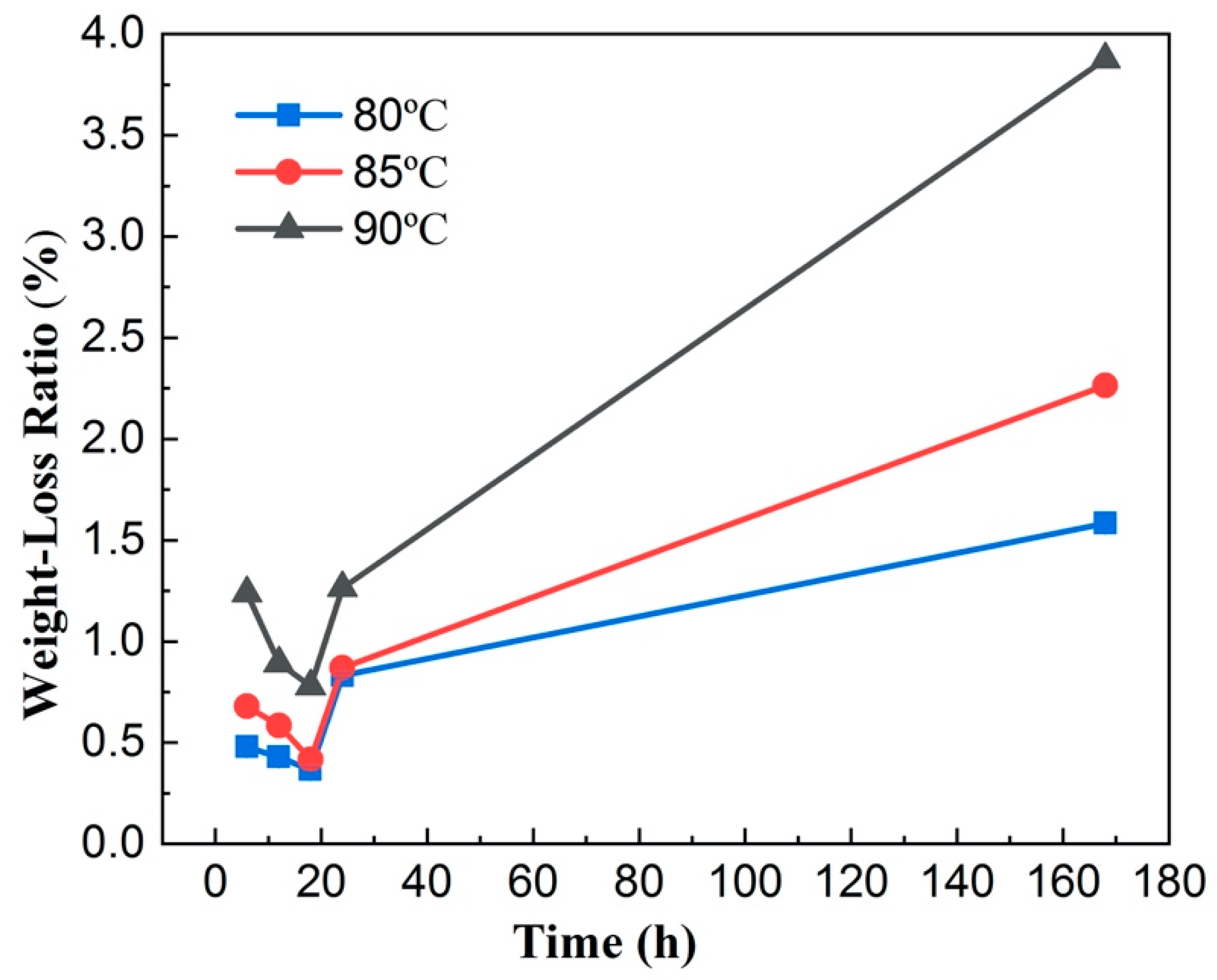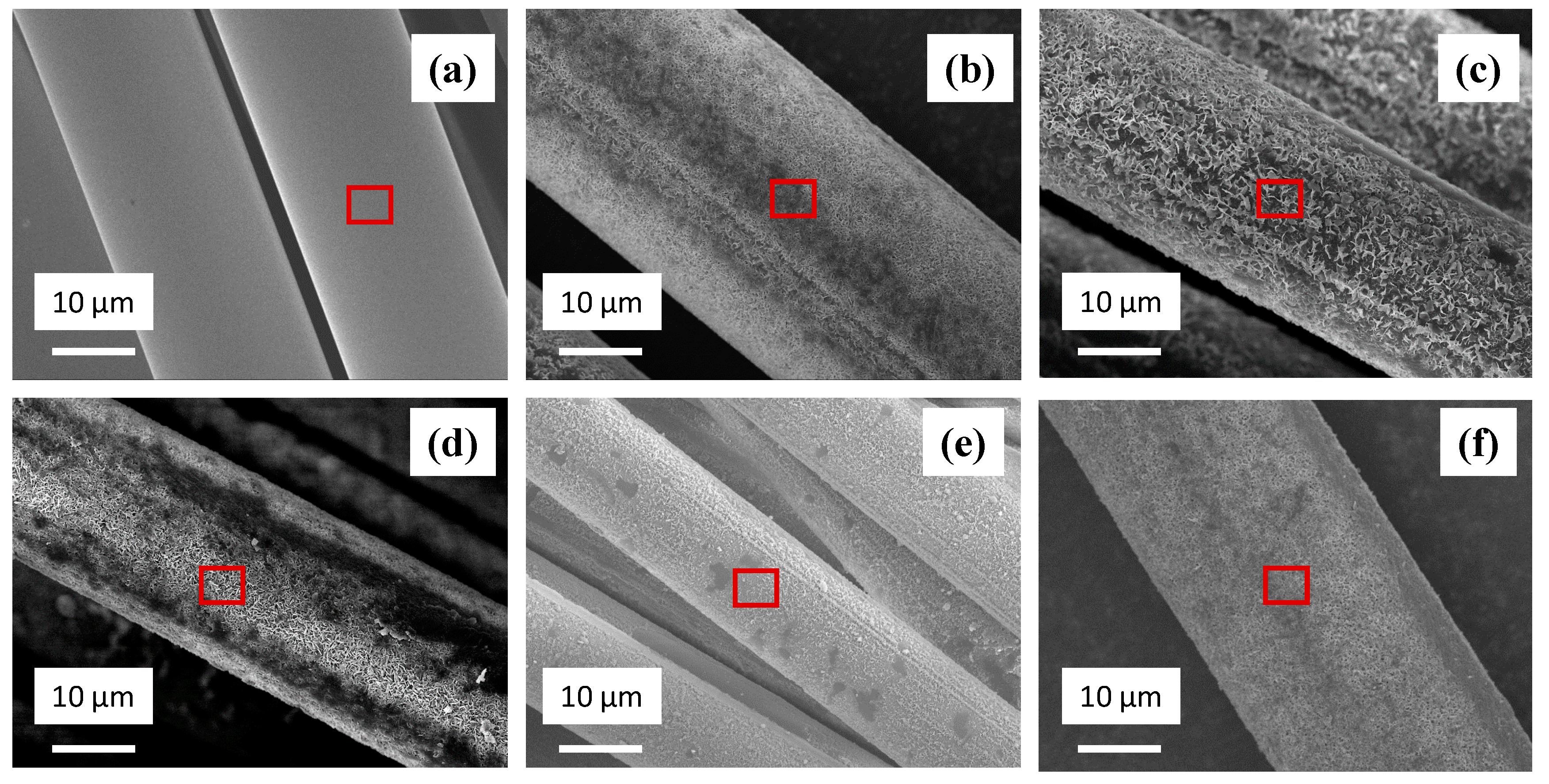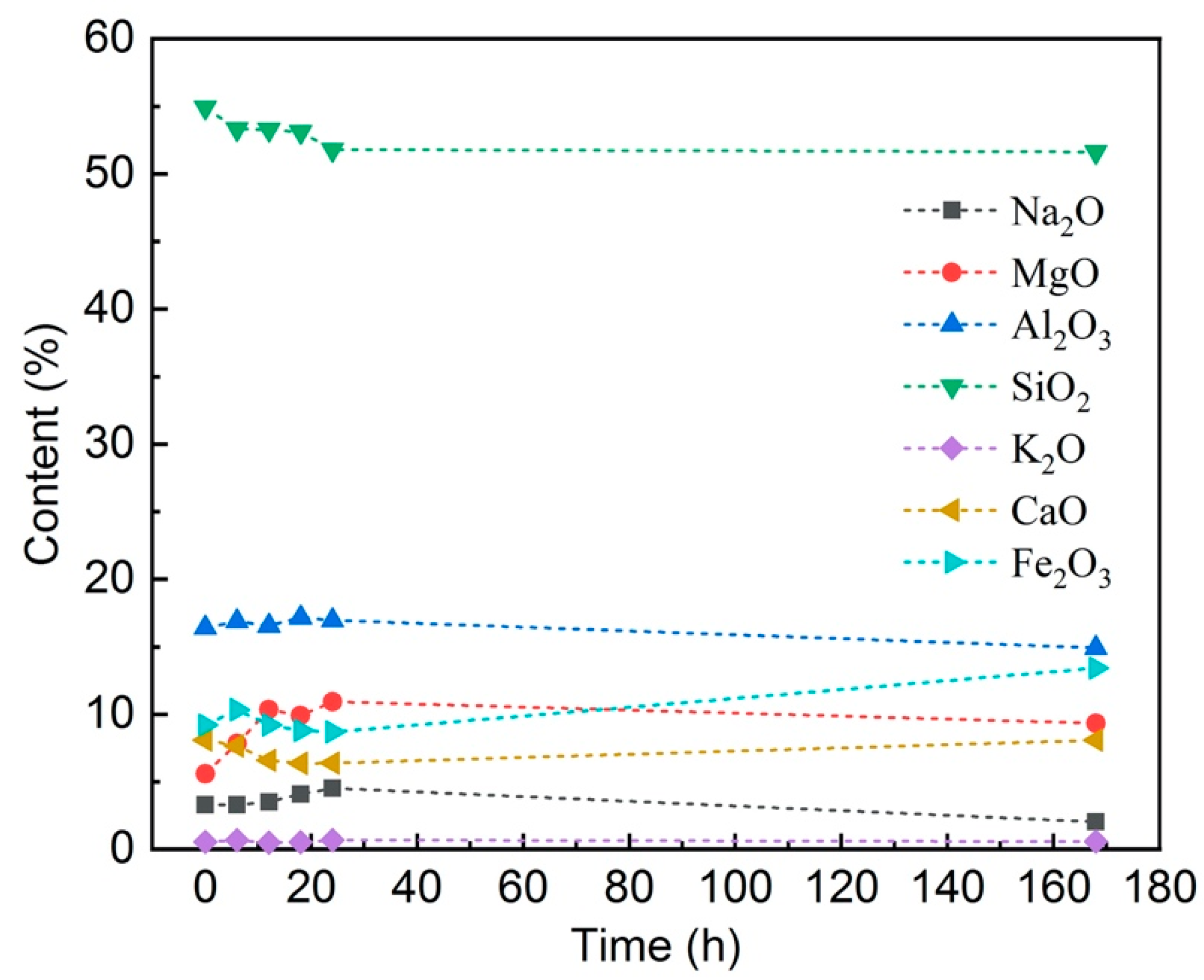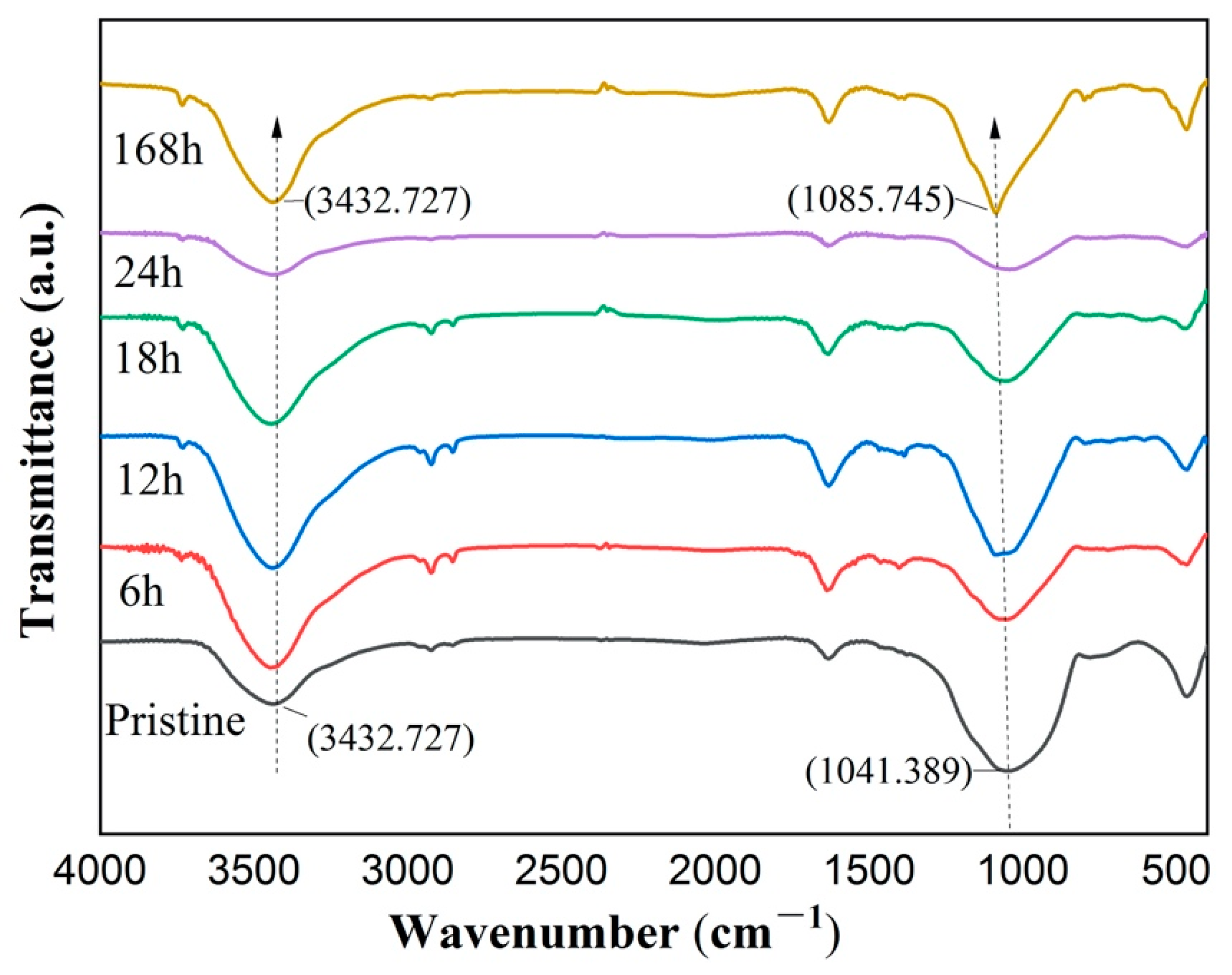Effect of Seawater Environment on the Structure and Performance of Basalt Continuous Fiber
Abstract
1. Introduction
2. Experiment
2.1. Sample Preparation
2.2. Characterization
3. Result and Analysis
3.1. Weight-Loss Ratio
3.2. Tensile Strength
3.3. Scanning Electron Microscopy (SEM) and Energy-Dispersive X-Ray Spectroscopy (EDS)
3.4. Microstructure (Fourier Transform Infrared (FT-IR) Spectroscopy)
4. Discussion
5. Conclusions
Author Contributions
Funding
Institutional Review Board Statement
Informed Consent Statement
Data Availability Statement
Conflicts of Interest
References
- Xing, D.; Xi, X.-Y.; Qi, M.-G.; Zheng, Q.-B.; Ma, P.-C. Optimization on the formulation of sizing to enhance the mechanical properties of basalt fiber. J. Text. Inst. 2021, 112, 515–525. [Google Scholar] [CrossRef]
- Chen, M.; Liu, J.; Wu, Z. Effect of Fe2O3 Concentration on the Properties of Basalt Glasses. J. Nat. Fibers 2020, 1–11. [Google Scholar] [CrossRef]
- Chen, X.; Zhang, Y.; Huo, H.; Wu, Z. Improving the tensile strength of continuous basalt fiber by mixing basalts. Fibers Polym. 2017, 18, 1796–1803. [Google Scholar] [CrossRef]
- Chen, X.; Zhang, Y.; Huo, H.; Wu, Z. Study of high tensile strength of natural continuous basalt fibers. J. Nat. Fibers 2018, 17, 214–222. [Google Scholar] [CrossRef]
- Sarasini, F.; Tirillo, J.; Seghini, M.C. Influence of thermal conditioning on tensile behaviour of single basalt fibres. Compos. Part B Eng. 2018, 132, 77–86. [Google Scholar] [CrossRef]
- Jamshaid, H. Basalt Fiber and its Applications. J. Text. Eng. Fash. Technol. 2017, 1, 1–3. [Google Scholar] [CrossRef]
- Afroz, M.; Patnaikuni, I.; Venkatesan, S. Chemical durability and performance of modified basalt fiber in concrete medium. Constr. Build. Mater. 2017, 154, 191–203. [Google Scholar] [CrossRef]
- Sun, X.; Gao, Z.; Cao, P.; Zhou, C. Mechanical properties tests and multiscale numerical simulations for basalt fiber reinforced concrete. Constr. Build. Mater. 2019, 202, 58–72. [Google Scholar] [CrossRef]
- Wang, X.; Zhao, X.; Wu, Z. Fatigue degradation and life prediction of basalt fiber-reinforced polymer composites after saltwater corrosion. Mater. Des. 2019, 163, 107529. [Google Scholar] [CrossRef]
- Dong, Z.; Wu, G.; Xu, B.; Wang, X.; Taerwe, L. Bond durability of BFRP bars embedded in concrete under seawater conditions and the long-term bond strength prediction. Mater. Des. 2016, 92, 552–562. [Google Scholar] [CrossRef]
- Xiong, Z.; Wei, W.; He, S.; Liu, F.; Luo, H.; Li, L. Dynamic bond behaviour of fibre-wrapped basalt fibre-reinforced polymer bars embedded in sea sand and recycled aggregate concrete under high-strain rate pull-out tests. Constr. Build. Mater. 2021, 276, 122195. [Google Scholar] [CrossRef]
- Li, C.; Gao, D.; Wang, Y.; Tang, J. Effect of high temperature on the bond performance between basalt fibre reinforced polymer (BFRP) bars and concrete. Constr. Build. Mater. 2017, 141, 44–51. [Google Scholar] [CrossRef]
- Sharma, S.; Zhang, D.; Zhao, Q. Degradation of basalt fiber–reinforced polymer bars in seawater and sea sand concrete environment. Adv. Mech. Eng. 2020, 12, 1687814020912888. [Google Scholar] [CrossRef]
- Bazli, M.; Li, Y.-L.; Zhao, X.-L.; Raman, R.S.; Bai, Y.; Al-Saadi, S.; Haque, A. Durability of seawater and sea sand concrete filled filament wound FRP tubes under seawater environments. Compos. Part B Eng. 2020, 202, 108409. [Google Scholar] [CrossRef]
- Lu, Z.; Xie, J.; Zhang, H.; Li, J. Long-Term Durability of Basalt Fiber-Reinforced Polymer (BFRP) Sheets and the Epoxy Resin Matrix under a Wet–Dry Cyclic Condition in a Chloride-Containing Environment. Polymers 2017, 9, 652. [Google Scholar] [CrossRef] [PubMed]
- Lu, Z.; Su, L.; Tan, S.; Li, Y.; Xie, J.; Liu, F. Long-term shear performance of bare and cement mortar-coated BFRP bars in corrosive environments. Constr. Build. Mater. 2020, 237, 117658. [Google Scholar] [CrossRef]
- Kim, D.; Mittal, G.; Kim, M.; Kim, S.; Rhee, K.Y. Surface modification of MMT and its effect on fatigue and fracture behavior of basalt/epoxy based composites in a seawater environment. Appl. Surf. Sci. 2019, 473, 55–58. [Google Scholar] [CrossRef]
- Ulus, H.; Kaybal, H.B.; Eskizeybek, V.; Avcı, A. Halloysite nanotube reinforcement endows ameliorated fracture resistance of seawater aged basalt/epoxy composites. J. Compos. Mater. 2020, 54, 2761–2779. [Google Scholar] [CrossRef]
- Sethi, S.; Ray, B.C. Environmental effects on fibre reinforced polymeric composites: Evolving reasons and remarks on interfacial strength and stability. Adv. Colloid Interface Sci. 2015, 217, 43–67. [Google Scholar] [CrossRef]
- Gutnikov, S.; Manylov, M.; Lipatov, Y.; Lazoryak, B.; Pokholok, K. Effect of the reduction treatment on the basalt continuous fiber crystallization properties. J. Non Cryst. Solids 2013, 368, 45–50. [Google Scholar] [CrossRef]
- D 1141-98 (Reapproved 2013). In Standard Practice for the Preparation of Substitute Ocean Water; ASTM International: West Conshohocken, PA, USA, 2013.
- Wang, Z.; Zhao, X.-L.; Xian, G.; Wu, G.; Raman, R.S.; Al-Saadi, S.; Haque, A. Long-term durability of basalt- and glass-fibre reinforced polymer (BFRP/GFRP) bars in seawater and sea sand concrete environment. Constr. Build. Mater. 2017, 139, 467–489. [Google Scholar] [CrossRef]
- BS ISO 11566:1996 Method B: Carbon fibre: Determination of the Tensile Properties of as Single-filament Specimens; International Organization for Standardization: Geneva, Switzerland, 1996.
- Kapeluszna, E.; Kotwica, Ł.; Różycka, A.; Gołek, Ł. Incorporation of Al in C-A-S-H gels with various Ca/Si and Al/Si ratio: Microstructural and structural characteristics with DTA/TG, XRD, FTIR and TEM analysis. Constr. Build. Mater. 2017, 155, 643–653. [Google Scholar] [CrossRef]
- Ahlawat, R. Effect of Concentration and Temperature on the Surface morphology of Gd 2 O 3 Nanocrystallites in Silica. Int. J. Appl. Ceram. Technol. 2014, 12, 1131–1139. [Google Scholar] [CrossRef]
- Ovchinnikov, O.V.; Evtukhova, A.V.; Kondratenko, T.S.; Smirnov, M.S.; Khokhlov, V.Y.; Erina, O.V. Manifestation of intermolecular interactions in FTIR spectra of methylene blue molecules. Vib. Spectrosc. 2016, 86, 181–189. [Google Scholar] [CrossRef]
- Basoglu, M.F.; Zerin, Z.; Kefal, A.; Oterkus, E. A computational model of peridynamic theory for deflecting behavior of crack propagation with micro-cracks. Comput. Mater. Sci. 2019, 162, 33–46. [Google Scholar] [CrossRef]
- Scudino, S.; Shahid, R.N.; Escher, B.; Stoica, M.; Li, B.S.; Kruzic, J.J. Mapping the cyclic plastic zone to elucidate the mechanisms of crack tip deformation in bulk metallic glasses. Appl. Phys. Lett. 2017, 110, 081903. [Google Scholar] [CrossRef]
- Rao, T.; Kumar, A.R.; Rao, B.H.; Veeraiah, N.; Reddy, M.R. Optical absorption, ESR, FT-IR spectral studies of iron ions in lead oxyfluoro silicate glasses. J. Mol. Struct. 2012, 1021, 7–12. [Google Scholar] [CrossRef]
- Pisciella, P.; Pelino, M. FTIR spectroscopy investigation of the crystallisation process in an iron rich glass. J. Eur. Ceram. Soc. 2005, 25, 1855–1861. [Google Scholar] [CrossRef]
- Morales, C.N.; Claure, G.; Emparanza, A.R.; Nanni, A. Durability of GFRP reinforcing bars in seawater concrete. Constr. Build. Mater. 2021, 270, 121492. [Google Scholar] [CrossRef]
- Tu, J.; Xie, H.; Gao, K. Prediction of the Long-Term Performance and Durability of GFRP Bars under the Combined Effect of a Sustained Load and Severe Environments. Materials 2020, 13, 2341. [Google Scholar] [CrossRef]






| Composition | SiO2 | Al2O3 | Fe2O3 | MgO | CaO | K2O | Na2O | Others |
|---|---|---|---|---|---|---|---|---|
| Content (wt%) | 54.90 | 16.40 | 9.20 | 5.60 | 8.10 | 0.55 | 3.30 | 1.95 |
| Composition | NaCl | MgCl2 | Na2SO4 | CaCl2 | KCl |
|---|---|---|---|---|---|
| Content (g/L) | 24.53 | 5.20 | 4.09 | 1.16 | 0.69 |
Publisher’s Note: MDPI stays neutral with regard to jurisdictional claims in published maps and institutional affiliations. |
© 2021 by the authors. Licensee MDPI, Basel, Switzerland. This article is an open access article distributed under the terms and conditions of the Creative Commons Attribution (CC BY) license (https://creativecommons.org/licenses/by/4.0/).
Share and Cite
Wang, Q.; Yan, T.; Ding, L. Effect of Seawater Environment on the Structure and Performance of Basalt Continuous Fiber. Materials 2021, 14, 1862. https://doi.org/10.3390/ma14081862
Wang Q, Yan T, Ding L. Effect of Seawater Environment on the Structure and Performance of Basalt Continuous Fiber. Materials. 2021; 14(8):1862. https://doi.org/10.3390/ma14081862
Chicago/Turabian StyleWang, Qingwei, Tan Yan, and Linfeng Ding. 2021. "Effect of Seawater Environment on the Structure and Performance of Basalt Continuous Fiber" Materials 14, no. 8: 1862. https://doi.org/10.3390/ma14081862
APA StyleWang, Q., Yan, T., & Ding, L. (2021). Effect of Seawater Environment on the Structure and Performance of Basalt Continuous Fiber. Materials, 14(8), 1862. https://doi.org/10.3390/ma14081862






